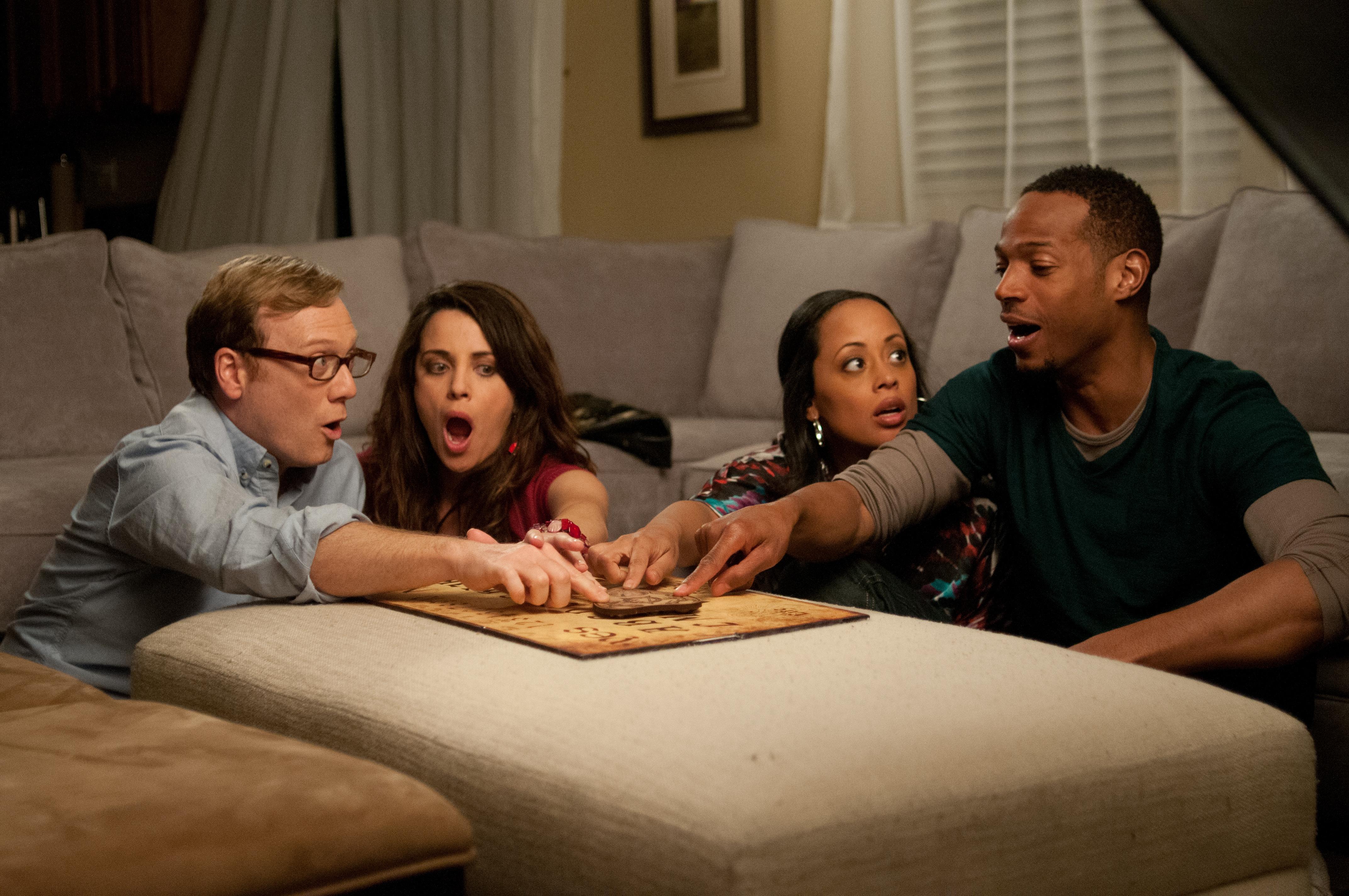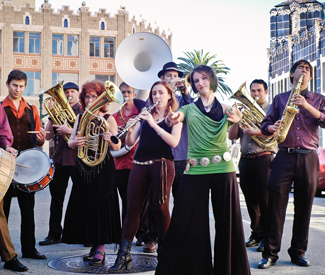Music listings are compiled by Emily Savage. Since club life is unpredictable, it’s a good idea to call ahead or check the venue’s website to confirm bookings and hours. Prices are listed when provided to us. Visit www.sfbg.com/venue-guide for venue information. Submit items for the listings at listings@sfbg.com. For further information on how to submit items for the listings, see Picks.
WEDNESDAY 26
ROCK/BLUES/HIP-HOP
Rome Balestrieri vs Guido Johnny Foley’s Dueling Pianos. 9pm, free.
Caldecott, Spooky Flowers, Dear Indugu, Collective W, Bailey Stone Hotel Utah. 8pm, $10.
Finish Ticket, Koruscant Weekend, Choirs Bottom of the Hill. 9pm, $10.
Keith Crossan’s Blues Showcase with Nancy Wright Biscuits and Blues. 8pm, $15.
Terry Savastano Johnny Foley’s. 9pm, free.
JAZZ/NEW MUSIC
Cat’s Corner with Nathan Dias Savanna Jazz. 9pm, $10.
Dink Dink Dink, Gaucho, Eric Garland’s Jazz Session Amnesia. 7pm, free.
Gennaro’s Wax Trio 144 King Art Cafe, SF; www.144kingcafe.com. 6-9, $10.
Amel Larrieux Yoshi’s SF. 8pm, $30; 10pm, $22.
Ricardo Scales Top of the Mark, 999 California, SF; www.topofthemark.com. 6:30pm, $5.
DANCE CLUBS
Booty Call Q-Bar, 456 Castro, SF; www.bootycallwednesdays.com. 9pm. Juanita MORE! and Joshua J host this dance party.
Coo-Yah! Slate Bar, 2925 16th St, SF; www.slate-sf.com. 10pm, free. With Vinyl Ambassador, DJ Silverback, DJs Green B and Daneekah.
Full-Step! Tunnel Top. 10pm, free. Hip-hop, reggae, soul, and funk with DJs Kung Fu Chris and Bizzi Wonda.
Hardcore Humpday Happy Hour RKRL, 52 Sixth St, SF; (415) 658-5506. 6pm, $3.
Housepitality F8, 1192 Folsom, SF. 10pm, free before 11pm at housepitalitysf.com.rsvp; $5-$10 after. With Perc, MossMoss, Brian Knarfield, Matt Richardson.
Martini Lounge John Colins, 138 Minna, SF; www.johncolins.com. 7pm. With DJ Mark Divita.
Timba Dance Party Bissap Baobab, 3372 19 St, SF; www.bissapbaobab.com.10pm, $5. With DJ Walt Diggz.
THURSDAY 27
ROCK/BLUES/HIP-HOP.
Frail, Horrorscopes, Emcee Infinite F8, 1192 Folsom, SF; thefrail.eventbee.com. 10pm, $15.
Annie Girl and the Flight, Sam Doores and the Tumbleweeds Amnesia. 9pm, $7.
Great White Buffalo, Cleveland Browns, Down and Outlaws Bottom of the Hill. 9pm, $10.
Growlers Fillmore. 8pm, $19.50.
Harry and the Hit Men Chapel, 777 Valencia, SF; www.thechapelsf.com. 9pm, $10-$20.
“Jingle Bell Rock and Metal Festival” DNA Lounge. 5:30pm, $12. With Chronic Vitality, Without Thought, Ashes in August, and more.
Sepalcure, Shlohmo Independent. 9pm, $25.
EC Scott Biscuits and Blues. 8 and 10pm, $20.
Soft Moon, popscene DJs Rickshaw Stop. 10pm, $12.
Stan Erhart Band Johnny Foley’s. 9pm, free.
Retromeca Pa’ina Lounge, 1865 Post, SF; www.painasf.com. 7:30pm.
Roags Tuttle vs Rome Balestrieri Johnny Foley’s Dueling Pianos. 9pm, free.
Zongo Junction, Skins and Needles Slim’s. 9pm, $15.
JAZZ/NEW MUSIC
Stompy Jones Top of the Mark, 999 California, SF; www.topofthemark.com. 7:30pm, $10.
Amel Larrieux Yoshi’s SF. 8pm, $30; 10pm, $22.
Savanna Jazz Jam with Eddy Ramirez Savanna Jazz. 7:30pm, $5.
FOLK/WORLD/COUNTRY
Barry O’Connell, Vinnie Cronin and Friends Starry Plough. 9pm.
Andre Thierry and Zydeco Magic Bissap Baobab, 3372 19 St, SF; www.bissapbaobab.com. 6pm, free.
Twang! Honky Tonk Fiddler’s Green, 1330 Columbus, SF; www.twanghonkytonk.com. 5pm. Live country music.
DANCE CLUBS
Afrolicious Elbo Room. 9:30pm, $5-$7. With DJ-host Pleasuremaker.
All 80s Thursday Cat Club. 9pm, $6 (free before 9:30pm). The best of ’80s mainstream and underground.
Base: Sammy D Vessel, 85 Campton Place, SF; www.vesselsf.com. 10pm, $10.
Ritual Dubstep Temple. 10pm-3am, $5. Trap and bass.
Tropicana Madrone Art Bar. 9pm, free. Salsa, cumbia, reggaeton, and more with DJs Don Bustamante, Apocolypto, Sr. Saen, Santero, and Mr. E.
FRIDAY 28
ROCK/BLUES/HIP-HOP
Back Pages Johnny Foley’s. 9pm, free.
Cherub, Battlehooch, Rappers Bottom of the Hill. 9:30pm, $12.
Classical Revolution presents Musical Art Quintet, Squid Inc. Brick and Mortar Music Hall. 8pm. $10-$20.
Cracker, Camper Van Beethoven Independent. 9pm, $27.
Rick Estrin and the Nightcats Biscuits and Blues. 8 and 10pm, $20.
Howlin’ Rain and Vetiver Cafe Du Nord. 9pm, $16.
Institution, Kingsborough, Lily Holbrook, February Zero, Cheating Daylight Great American Music Hall. 6:30pm, $15.
Daniel Krass, Rome Balestrieri, Jason Marion Johnny Foley’s Dueling Pianos. 9pm, free.
Metermen, DJ Harry Duncan Regency Ballroom. 9pm, $48-$50.50.
RootiCal Players feat. Amha Baraka 50 Mason Social House, SF; www.50masonsocialhouse.com. 10pm, $5.
Sporting Life, Love Dimension, Y Axes Hemlock Tavern. 9:30pm, $7.
Tortured Soul, Frankie Boissey Boom Boom Room. 8pm, $20.
Victims Family, Black Cobra, Prizehog, End the Suffering Elbo Room. 9pm, $10.
X-Mas with X, My Jerusalem Slim’s. 9pm, $32.
Zeds Dead, Adventure Club Warfield. 9pm, $38-$45.
JAZZ/NEW MUSIC
Audium 1616 Bush, SF; www.audium.org. 8:30pm, $20. Theater of sound-sculptured space.
Black Market Jazz Orchestra Top of the Mark, 999 California, SF; www.topofthemark.com. 9pm, $10.
Pat O’Donnell and Friends Starry Plough. 9pm.
Maceo Parker’s Funky New Year’s Party Yoshi’s SF. 8pm, $35; 10pm, $25.
Savanna Jazz Trio Savanna Jazz. 7:30pm, $8.
FOLK/WORLD/COUNTRY
Baxtolo Drom Amnesia. 9pm, $7-$10.
Trio Troubadour Bissap Baobab, 3372 19 St, SF; www.bissapbaobab.com. 8pm, free.
DANCE CLUBS
Fareoh, St. John, B33son and Jays One Vessel, 85 Campton Place, SF; www.vesselsf.com. 10pm, $20-$30.
Rob Garza DJ set (Thievery Corporation) Public Works. 9:30pm, $13.
Joe Lookout, 3600 16th St.,SF; www.lookoutsf.com. 9pm. Eight rotating DJs.
MartyParty, Kitty D, Bogl vs Dials, Audiovoid, WolfBitch Mighty. 9pm, $10.
Odyssey Public Works Loft. 9:30pm, $10.
Old School JAMZ El Rio. 9pm. Fruit Stand DJs spinning old school funk, hip-hop, and R&B.
Paris to Dakar Little Baobab, 3388 19th St, SF; (415) 643-3558. 10pm, $5. Afro and world music with rotating DJs including Stepwise, Steve, Claude, Santero, and Elembe.
SATURDAY 29
ROCK/BLUES/HIP-HOP
Anthem Johnny Foley’s. 9pm, free.
Communist Kayte, Sean O’Brien and His Dirty Hands, Severe Bass and the Bad Decisions Thee Parkside. 3pm, free.
Karl Denson’s Tiny Universe, Robert Randolph and the Family Band Regency Ballroom. 8pm, $35.
Hornss, Lozen, Tacos! Hemlock Tavern. 9:30pm, $7.
Hot Buttered Rum and Family, Dead Winter Carpenters Brick and Mortar Music Hall. 9pm. $20-$67.50.
Howlin’ Rain and Vetiver Cafe Du Nord. 9pm, $16.
Keyser Soze, Jamaicans, Delirians, Revivers Rockit Room, 9pm.
Jason Marion, Rome Balestrieri, Daniel Krass Johnny Foley’s Dueling Pianos. 9pm, free.
Melvins Great American Music Hall. 8pm, $21.
Midtown Social, Niners, Bruises Bottom of the Hill. 10pm, $10.
Reggae Massive Bissap Baobab, 3372 19 St, SF; www.bissapbaobab.com.10pm, $3. With DJ Rudy.
Earl Thomas and the Blues Ambassadors Biscuits and Blues. 8 and 10pm, $22.
Trainwreck Riders Riptide. 9:30pm, free.
Trombone Shorty and Orleans Avenue, Stone Foxes Fillmore. 9pm, $35.
X-Mas with X, My Jerusalem Slim’s. 9pm, $32.
JAZZ/NEW MUSIC
Audium 1616 Bush, SF; www.audium.org. 8:30pm, $20. Theater of sound-sculptured space.
Anna Estrada (Latin Jazz) Savanna Jazz. 7:30pm, $8.
Maceo Parker’s Funky New Year’s Party Yoshi’s SF. 8pm, $35; 10pm, $30.
FOLK/WORLD/COUNTRY
Benjamin Brown Starry Plough. 9pm.
Sankofa Africa Bissap Baobab, 3372 19 St, SF; www.bissapbaobab.com. 7:30pm, free.
Craig Ventresco and Meredith Axelrod Atlas Cafe, 3049 20 St, SF; www.atlascafe.net. 4-6pm.
DANCE CLUBS
All Male Strip Revue with Female Trouble Amnesia. 9pm.
Steve Aoki Warfield. 8pm, $25. (Afterparty) Ruby Skye. 9pm, $45.
Bootie SF: Pre-NYE Non-Amateur Night DNA Lounge. 9pm, $10.
Lee Burridge Public Works. 9:30pm, $25.
Paris to Dakar Little Baobab, 3388 19th St, SF; (415) 643-3558. 10pm, $5. Afro and world music with rotating DJs.
Steve Smooth, Lucas Med Vessel, 85 Campton Place, SF; www.vesselsf.com. 10pm, $20-$30.
Sweaterfunk and Funkmosphere Elbo Room. 9pm, $10. Hosted by K-Maxx.
SUNDAY 30
ROCK/BLUES/HIP-HOP
Dawes, Blake Mills Independent. 8pm, $30; $110 two-day ticket.
Hot Buttered Rum and Family, Brothers Comatose, Zac Matthews Brick and Mortar Music Hall. 9pm. $20-$67.50.
Aaron Mort and the Aaron Mort Band, Chuckleberries, Gregors, Peachelope Cocktail Hour Hemlock Tavern. 7pm, $6.
John Nemeth Biscuits and Blues. 7 and 9pm, $20.
Primus Warfield. 9pm, $52-$75.
Range of Light Wilderness, Sandy, Au Dunes Amnesia. 9pm, $7-$10.
Terry Savastano Johnny Foley’s. 9pm, free.
“San Francisco Battle of the Bands Finals” DNA Lounge. 5:30pm, $12.
Trombone Shorty and Orleans Avenue, Pimps of Joytime Fillmore. 9pm, $35.
Greg Zema vs Rome Balestrieri Johnny Foley’s Dueling Pianos. 9pm, free.
JAZZ/NEW MUSIC
Adelante Latin Jazz Band Savanna Jazz. 7pm, $7.
Maceo Parker’s Funky New Year’s Party Yoshi’s SF. 7pm, $30; 9pm, $25.
FOLK/WORLD/COUNTRY
Brazil and Beyond Bissap Baobab, 3372 19 St, SF; www.bissapbaobab.com. 6:30pm, free.
Marla Fibish and Friends Starry Plough. 9pm.
Twang Sunday Thee Parkside. 4pm, free. With Gravel Spreaders.
DANCE CLUBS
Beats for Lunch Thee Parkside. 11am, free. With DJ Matt Haze and Chef Josie.
Dub Mission Elbo Room. 9pm, $6. With DJ Sep, Robert Rankin, Spliff Skankin.
MONDAY 31
ROCK/BLUES/HIP-HOP
Buckethead Great American Music Hall. 9pm, $50.
Con Brio, Mark Sexton Band, DJ K-os Boom Boom Room. 8pm, $50.
Cut Loose Band Johnny Foley’s. 9pm, $20.
Dawes, Blake Mills Independent. 9pm, $95; $110 two-day ticket (open bar).
Erk the Jerk, Steve Lan, DJ Double R, hosted by Ray J Slim’s. 9pm.
Fresh and Onlys, Sonny and the Sunsets, Kelly Stoltz, Extra Classic Chapel, 777 Valencia, SF; www.thechapelsf.com. 8:30pm, $25-$35.
Futuropolis 1050 Folsom. 9pm, $15. With Star Slinger, Holy Other, LowRIDERz, Polish Ambassador, Mykki Blanco, and more.
Sean Hayes, Hurray for the Riff Raff, Slow Motion Cowboys Amnesia. 9pm, $15 (incl. champagne toast).
John Lee Hooker Biscuits and Blues. 8pm, $50; 11pm, $60.
Hot Buttered Rum and Family, Ten Mile Tide Brick and Mortar Music Hall. 9pm. $33-$67.50.
Howlin’ Rain and Vetiver Cafe Du Nord. 9:30pm, $35.
Primus Warfield. 9pm, $52-$75.
Remones (Ramones tribute) Riptide. 9:30pm, free.
Tainted Love, Stung (Police tribute) Regency Ballroom. 9om, $55.
Nathan Temby, Rome Balestrieri, Daniel Krass Johnny Foley’s Dueling Pianos. 9pm, $20.
Terry Malts, Toys That Kill, Pins of Light Hemlock Tavern. 9pm, $12.
Trombone Shorty and Orleans Avenue, Papa Mali Fillmore. 9pm, $75.
Tumbleweed Wanderers (two sets), Big Tree, She’s Bottom of the Hill. 9pm, $25.
Turquoise Jeep, popscene DJs Rickshaw Stop. 8pm, $45-$50.
Nick Waterhouse, Quinn Deveaux and the Blue Beat Review, Gaucho Bimbo’s. 8pm, $60.
Zodiac Death Valley, Spiral Electric, Down and Outlaws, Creepers 50 Mason Social House, SF; www.50masonsocialhouse.com. 7pm, $15.
JAZZ/NEW MUSIC
New Year’s Eve at Savanna Jazz Savanna Jazz. 6:30pm, $20.
Maceo Parker’s Funky New Year’s Party Yoshi’s SF. 8pm, $50; 10pm, $100.
FOLK/WORLD/COUNTRY
Hillbilly New Years Eve Starry Plough. 9:30pm, $10-$15. With Windy Hill.
DANCE CLUBS
Afrolicious NYE Elbo Room. 9pm, $15-$30. With Afrolicious, Will Magid, DJ Lucio K.
Bootie SF: NYE 2013 DNA Lounge. 9pm, $30-$40. With A Plus D, Mykill, Adrian and Mimi, Vau de Vire Society, and more.
Club 1994 New Years Eve Ball Vessel, 85 Campton Place, SF; www.vesselsf.com. 10pm, $50-$100. With Jeffrey Paradise, Vin Sol.
Dark Room NYE Hot Spot, 1414 Market, SF; Facebook: DarkRoomSF. 10pm, $5-$7. With B-R-A-N-E-S, Little Debbie.
For additional New Year’s Eve listings, go to page 27.
TUESDAY 1
ROCK/BLUES/HIP-HOP
Eric Bolivar’s Hangover Party Brick and Mortar Music Hall. 9pm. $7-$10. With Brian J and David Bailis, Eric McFadden, and more.
Stan Erhart Band Johnny Foley’s. 9pm, free.
DANCE CLUBS
Breakfast in Bed: NYE After Party Supperclub, 657 Harrison, SF; www.supperclub.com. 4am, $15-$150 VIP bed reservations. With breakfast, David Harness, Galen, Rooz, and more.












